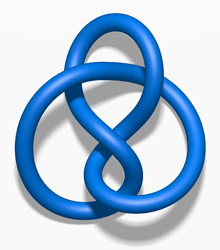Fibered knot

In knot theory, a branch of mathematics, a knot or link in the 3-dimensional sphere is called fibered or fibred (sometimes Neuwirth knot in older texts, after Lee Neuwirth) if there is a 1-parameter family of Seifert surfaces for , where the parameter runs through the points of the unit circle , such that if is not equal to then the intersection of and is exactly .
For example:
- The unknot, trefoil knot, and figure-eight knot are fibered knots.
- The Hopf link is a fibered link.
Fibered knots and links arise naturally, but not exclusively, in complex algebraic geometry. For instance, each singular point of a complex plane curve can be described topologically as the cone on a fibered knot or link called the link of the singularity. The trefoil knot is the link of the cusp singularity ; the Hopf link (oriented correctly) is the link of the node singularity . In these cases, the family of Seifert surfaces is an aspect of the Milnor fibration of the singularity.
A knot is fibered if and only if it is the binding of some open book decomposition of .
Knots that are not fibered
The Alexander polynomial of a fibered knot is monic, i.e. the coefficients of the highest and lowest powers of t are plus or minus 1. Examples of knots with nonmonic Alexander polynomials abound, for example the twist knots have Alexander polynomials qt − (2q + 1) + qt−1, where q is the number of half-twists.[1] In particular the Stevedore's knot is not fibered.
See also
References
External links
- Harer, John (1982). "How to construct all fibered knots and links". Topology. 21 (3): 263–280. doi:10.1016/0040-9383(82)90009-X.
- http://www.msp.warwick.ac.uk/gt/2010/14-04/p050.xhtml